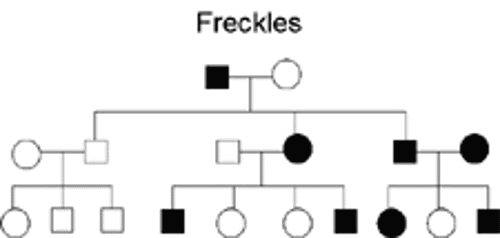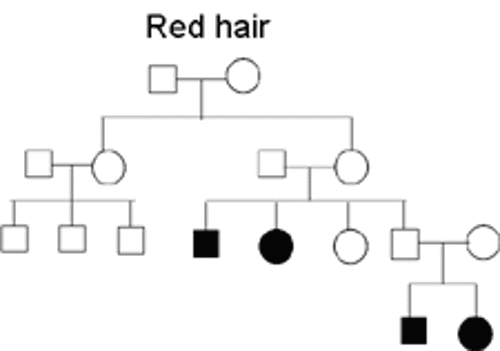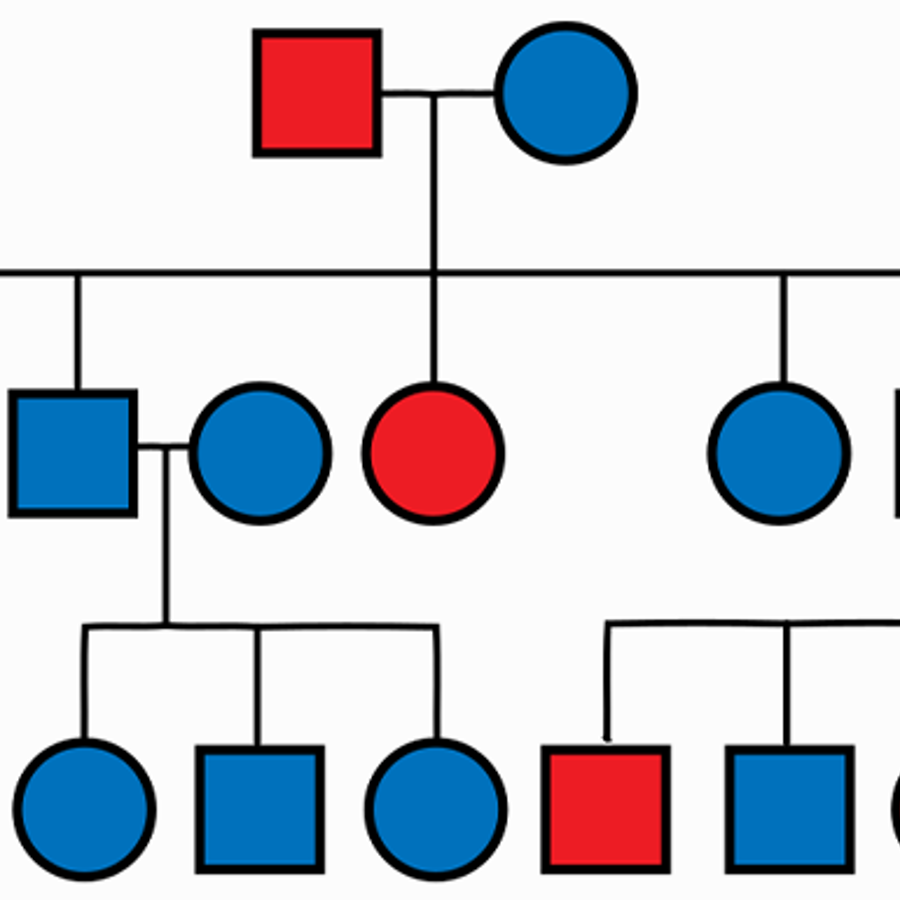
How do you know what eye color for example would be dominant or recessive?
June 3, 2010

- Related Topics:
- Eye color,
- Dominant and recessive,
- Classical genetics
A middle school student from California asks:
"How do you know what eye color for example would be dominant or recessive?"
This is a great question that gets to the heart of genetics. The answer will help us understand how we get certain traits from our parents. It'll also give us a basic idea about how genetics works.
The short answer to your question is that scientists look at a family's history to figure out whether something is dominant, recessive, or neither. They look to see which family members have which traits and how a trait is passed down.
For example, if a trait tends to be directly passed from parent to child, then the odds are pretty good that the trait is a dominant one. If a trait skips generations or pops up out of nowhere, then the odds are pretty good that it is recessive. If the trait ends up a blending of the two parents' traits, then it isn't either.
There are lots of other hints and clues you can get from looking at a family's history. There are lots of exceptions too. But this gives you a basic idea about what is involved in figuring out whether a trait is dominant or not.

What I want to do now is go through an example to show how you might go about figuring it out. At the end I'll have some examples that you can try yourself to see if you've got it.
What we'll do is make a family tree. This is really just an easy way to display all of a family's traits over many generations. Then we'll apply some rules to try to figure out which trait is dominant and which one is recessive.
But first, a little background…
Genetics Basics
Your DNA is like an instruction manual. It has all of the instructions for making you who you are, how you look and even how you act. Those instructions come in the form of genes.
Each gene has the instructions for one small part of you. For example, there is a gene that decides whether your hair is red or not.
Sometimes a bunch of genes need to work together to cause a trait. In these cases, each gene contributes a bit towards that trait. For example, your eye color came from a set of eye color genes.
You get one copy of each gene from each parent. This means you have two copies of most of your genes. So you have two copies of each of your eye color genes.
But not all copies of genes are alike! In fact that is where all the wonderful variety around us comes from. We all have pretty much the same genes, just different versions or alleles. And not all versions of a gene are created equal.
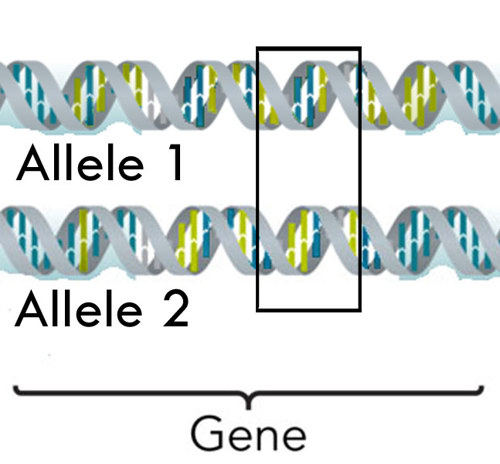
Some versions are stronger than others. The stronger version is called dominant and the weaker one recessive. Because of this, dominant alleles almost always win over recessive ones. (Click here to see a video that goes over all of this.)
For example, imagine a child gets a blue version of an eye color gene from mom and a brown one from dad. What color eyes will the child have? It depends on which is dominant.
Let's now use a family tree to figure out what eye color the child will have. In the process, we'll learn about dominant and recessive alleles.
An Eye Color Family Tree
As I said before, geneticists use family trees to figure out if a trait is dominant or recessive. A family tree is really just an easy way to display a family's information. It lets you easily see how traits are passed down in each generation.
In a family tree, boys are squares and girls are circles. Horizontal lines connecting a circle and a square mean that the couple had kids. The kids are shown with a vertical line going down.
Let's take a look at a family tree and see how it can help us decide which eye color is dominant.
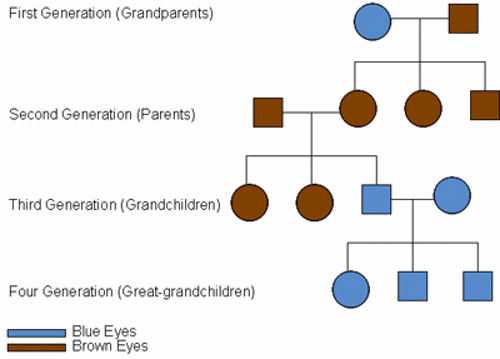
We'll start out by describing what we see:
In this family the grandparents have 3 children (2 daughters and a son). All three kids are born with brown eyes even though the grandmother has blue eyes. Interestingly, when one of the daughters has kids with a man that also has brown eyes, one of their sons ends up with blue eyes. Finally, when that son has kids with a blue-eyed woman, all the children have blue eyes.
OK now we're ready. It can seem overwhelming at first but if we apply a few rules, we'll know what to look for.
1) If a person shows a trait that is dominant then at least one of their parents must always show the trait.
This rule comes from the fact that the dominant allele always wins. Based on the rule, it seems that brown is the dominant trait.
We can tell this by looking at the second generation. Notice that there are two brown eyed parents in this generation and they have a blue eyed child. This isn't possible unless brown is dominant over blue.
If brown were recessive, then each parent would only have brown alleles. Which means that they could only pass brown alleles to their kids. This clearly didn't happen since they had a blue eyed child. Therefore brown is probably dominant over blue.
2) Recessive traits skip generations in many cases. Grandparents and their grandchildren may well show it even if the parents did not.
You see this pattern for blue eyes in part of our family tree sample. The grandmother has blue eyes and you only see this trait showing up again in the grandchildren. This suggests that blue is recessive to brown.
3) If both parents show a recessive trait, then all children must show that trait too.
This is clearly not the case with brown because the brown-eyed parents in the second generation had a kid with blue eyes. On the other hand, when the blue-eyed male in the third generation has kids with a blue-eyed woman all their children have blue eyes.
So the brown eyed parents in the second generation must have had a hidden blue eye gene for them to have a blue eyed child. This means blue is recessive to brown.
Also, since the blue eyed parents of the third generation had only blue eyed kids, this suggests that blue is recessive. As we'll talk about in a little bit, this particular case is not a for sure thing. We can come up with other ways that two blue eyed parents could have only blue eyed kids. But it does support the idea that blue is recessive.
4) A person can only show a recessive trait if both of his parents carried at least one copy each of the recessive allele. The parents do not need to show the trait, as one copy is not enough to reveal it, but they must both carry it.
This holds true if we assume having blue eyes are recessive. That is exactly what you see happening in the kids from the third generation. Both parents in the second generation have brown eyes but must carry the recessive blue allele. As a consequence their son has blue eyes because he got a recessive allele from each parent.
A word of caution
Of course we need to be careful here. These rules only work if there is a big family history that always supports it.
Let's look at an example of what I mean. If the dad (from the first generation) had one copy of each allele, then all the kids could end up with blue eyes. Remember, if dad has one brown and one blue allele, he'll have brown eyes but could pass the blue one down to his kids (as shown in the figure).
Which gene version gets passed down is totally random -- like flipping a coin. Just like it is possible to get three heads in a row when you flip a coin, it is also possible to pass the same gene version three times in a row. In other words, it is possible for these parents to have all blue eyed kids.
In fact, the chances of this happening are around 1 in 8. If the dad were to pass the blue gene version three times in a row, then all three kids in the second generation could have blue eyes.
There are other situations where we need to be careful too. For example, if we had a family of all blue-eyed people, then it might look like blue is dominant because parents always pass it on to their kids.
It is for these reasons we usually need more than one generation and lots of different families to figure these things out. Each observation is evidence that a trait is either dominant or recessive.
(As a side note, this type of family tree study is why so many genetic myths exist! If you look at only a few small families, you might reach the wrong conclusion. Even with eye color, the truth is more complicated than this tree shows. This family doesn’t even have green eyes, and we’re ignoring a lot of more subtle variation like shades of brown.)
Bringing it all Home
OK, so from this we can figure out that brown is dominant over blue. Now we know that if someone has a brown allele and a blue allele, they'll have brown eyes.
We can also figure out which allele each person carries. To make this easier, we need to use a little genetics shorthand. When we show something as dominant, we use capital letters. For the recessive allele we use lowercase.
So in the case of brown eyes we use B. In the case of blue we use b.
As I mentioned above, people have two copies of each gene, which means that you can have BB or Bb and have brown eyes. However, you can only have blue eyes if you are bb.
In other words, a dominant allele will always allow a specific trait to show up no matter if we have two dominant copies (BB) or just one (Bb). A trait from a recessive allele will only appear if it is paired with another recessive allele (bb).
So based on that information let's have some fun filling out the family tree:
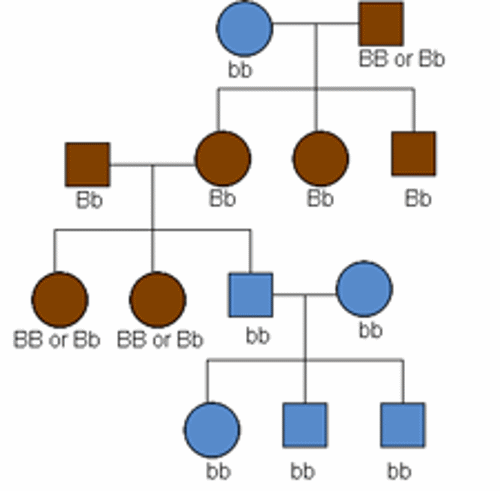
As a final point, genetics is rarely this simple. There are always exceptions to genetics rules.
For example, sometimes a dominant trait won't be seen because of something called incomplete penetrance. Or a new mutation could happen between generations, confusing the interpretation. Again, we can get around these things by looking at lots of family trees.
Some Homework
Here are a few samples of family trees so you can practice. Can you figure out what traits are dominant or recessive?
1. The black circles and squares represent people with freckles. Are freckles dominant or recessive? Click on the image to see if you guessed right. (Click here to learn more about the genetics of freckles.)
2. The black circles and squares represent people with red hair. Is red hair dominant or recessive? Click on the image to see if you guessed right. (Click here to learn more about the genetics of red hair.)

Author: Erika Bustamante
When this answer was published in 2010, Erika was a Ph.D. candidate in the Department of Developmental Biology, studying the genetic regulation of pancreas development in Seung Kim’s laboratory. Erika wrote this answer while participating in the Stanford at The Tech program.
 Skip Navigation
Skip Navigation

